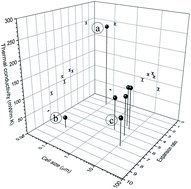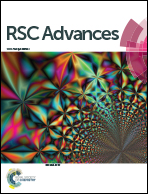From micro/nano structured isotactic polypropylene to a multifunctional low-density nanoporous medium
Abstract
A homogeneous nano-porous medium of isotactic polypropylene (iPP) was fabricated using supercritical carbon dioxide (scCO2). A unique complex 3-dimensional nano-fibrillar network, using sorbitol derivatives, was induced inside iPP to gel the matrix. The nucleating/clarifying agent, 1,2,3-trideoxy-4,6:5,7-bis-O-[(4-propylphenyl)methylene]-nonitol (TBPMN), was used to promote crystal nucleation, which in turn dramatically enhanced nanocell nucleation. This clarifying agent (CA) has been developed as a new generation sorbitol derivative to improve the clarity of polypropylene (PP). Samples of iPP with the clarifying agent (iPP/CA) were prepared using a twin-screw microcompounder, and their thermal stability was accessed. The crystallization behaviors of the neat iPP (iPP/0CA) and iPP with 0.5 wt% CA (iPP/0.5CA) were studied using differential scanning calorimetry (DSC), polarized optical microscopy, and rheometry. The percolation state of the sorbitol nano-fibrillar network in iPP/0.5CA was also investigated using the Van Gurp–Palmen-plot. The cellular morphology was characterized as a function of the processing conditions at both the micro and nano-scales. A nanocellular structure with an average pore size of ∼70 nm, cell density of ∼1015 cells per cm3, and void fraction of 86% (an expansion ratio of 7.56) was achieved by controlling the crystallization kinetics of iPP in the presence of CA. An optimum foaming temperature was found wherein the smallest pore size with the highest cell density could be produced. The thermal conductivity of the nanoporous sample decreased dramatically up to about 8-fold compared with its solid counterpart. Its viability stemmed from its relative low density, unique 3D nanocellular structure, and nanoscale confinement of the gaseous medium inside the nanopores (i.e., the Knudsen effect).


 Please wait while we load your content...
Please wait while we load your content...